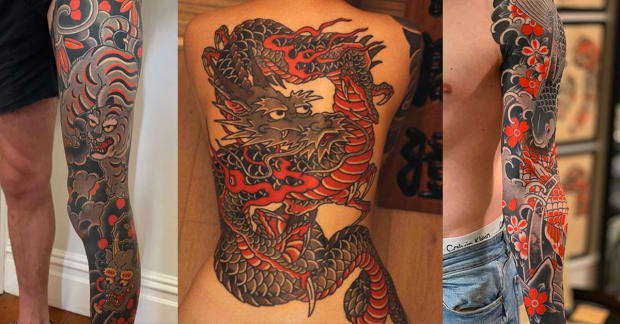Tattoos have a long and rich history in both Chinese and Japanese cultures. In ancient times, tattoos were used to denote social status, religious beliefs, and personal identity. Today, tattoos have become a form of self-expression and art. Both Chinese and Japanese tattoos are steeped in tradition, symbolism, and meaning. However, there are distinct differences between the two styles. In this article, we’ll explore the differences between Chinese and Japanese tattoos.
Origins and Historical Significance of Chinese and Japanese Tattoos
Tattoos in China and Japan have a long and rich history. In China, tattoos were used to signify social status and rank in society. During the Zhou Dynasty, tattoos were used to distinguish slaves from free people. The Han Dynasty used tattoos to mark criminals and convicts. Later, tattoos were used to identify members of secret societies and criminal organizations.
In Japan, tattoos were also used to denote social status, but they also had spiritual and religious significance. The Ainu people of Hokkaido, Japan, were among the first to use tattoos as a form of identification. Tattoos were also used to protect against evil spirits and to signify allegiance to a particular deity.
Key Differences in Chinese and Japanese Tattoo Artistry
Chinese and Japanese tattoos have distinct differences in their artistic style. Chinese tattoos are characterized by bold lines and vibrant colors. They often feature animals, dragons, and other mythical creatures. Chinese tattoos are often large in scale and cover a significant portion of the body.
Japanese tattoos, on the other hand, are more intricate and detailed. They often feature flora and fauna, such as cherry blossoms and koi fish. Japanese tattoos also have a distinct shading technique called “irezumi,” which involves filling in the design with color and shading using a traditional hand-poked technique. Japanese tattoos are often smaller in scale and placed in specific areas of the body.
Symbolism and Meanings in Chinese and Japanese Tattoos
Both Chinese and Japanese tattoos are rich in symbolism and meaning. Chinese tattoos often feature animals, such as the dragon and the tiger, which represent strength and power. The phoenix represents rebirth and renewal, while the koi fish symbolizes perseverance and determination. Chinese tattoos also often feature characters and calligraphy, which convey meaning through the written word.
In Japanese tattoos, cherry blossoms symbolize the transience of life, while the lotus flower represents enlightenment and spiritual growth. The koi fish, a popular motif in both Chinese and Japanese tattoos, represents determination and perseverance. Dragons, tigers, and other mythical creatures often represent strength and power. Geisha and samurai tattoos also have spiritual significance, representing honor, loyalty, and perseverance.
Tattoo Placement and Cultural Significance
In Chinese and Japanese cultures, the placement of tattoos is significant. In China, tattoos were often placed on the back and shoulders, as they were considered the most honorable and respected areas of the body. In Japan, tattoos were often placed on the arms, chest, and back. Tattoos were often hidden by clothing, as they were associated with criminality and social stigma.
Today, Chinese and Japanese tattoos are often placed on more visible areas of the body, such as the arms, legs, and chest. However, there is still some stigma attached to tattoos in both cultures. In China, tattoos are often seen as a sign of rebellion and non-conformity, while in Japan, tattoos are still associated with the yakuza and other criminal organizations.
Modern Trends and Popularity in Chinese and Japanese Tattoos
In recent years, both Chinese and Japanese tattoos have gained popularity around the world. Many people are drawn to the rich symbolism and intricate artistry of these styles. However, it’s important to respect the cultural significance of these tattoos and their origins.
Modern trends in Chinese and Japanese tattoos include a fusion of traditional and contemporary styles. Some artists combine elements of both styles to create unique and personalized designs. Others incorporate modern themes and motifs, such as pop culture references or abstract designs.
Which Style is Right for You?
Choosing between Chinese and Japanese tattoos ultimately comes down to personal preference and individual meaning. Both styles have their own distinct characteristics and symbolism. It’s important to do your research and work with a reputable and experienced tattoo artist who specializes in the style you are interested in.
In conclusion, Chinese and Japanese tattoos are steeped in tradition, symbolism, and meaning. While there are distinct differences between the two styles, both are rich in history and culture. Whether you are drawn to the bold lines and vibrant colors of Chinese tattoos or the intricate shading and detail of Japanese tattoos, it’s important to respect the origins and cultural significance of these art forms. Looking for a tattoo shop in Box Hill and the surrounding south eastern suburbs of Melbourne? Check out China Zone Tattoo.





